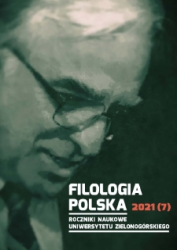Contextual determinants of adverbs of degree occurrence in conjunction with the adjective beautiful
Keywords
Abstract
The subject of the analysis presented in the article are the adverbs of degree showing strong syntactic connectivity with the adjective piękny (‘beautiful’), forming compounds with this adjective with the status of collocation. The purpose of the study – using corpus data – is to trace the contextual determinants of the occurrence of these adverbs and demonstrate the dependence of their selection on what type of object is aesthetically assessed in a given statement. The study has shown that some of these adverbs are stronger and others less dependent on these determinants. This relationship strength depends on the way (strategy) in which a given adverb expresses the attribute’s intensity.
References
Bałabaniak D., Polskie intensyfikatory leksykalne na tle wyrażeń gradacyjnych, Opole 2013.
[Google Scholar]
Bartmiński J., Panasiuk J., Stereotypy językowe, [w:] Współczesny język polski, red. J. Bartmiński, Lublin 2001.
[Google Scholar]
Bolinger D., Degree words, Haga-Paryż 1972.
[Google Scholar]
Červenkova I., O pokazateljach mery priznaka. (Na materiale sovremennogo russkogo literaturnogo jazyka), Sofia 1975.
[Google Scholar]
Grzegorczykowa R., Funkcje semantyczne i składniowe polskich przysłówków, Wrocław 1975.
[Google Scholar]
Janus E., „Bardzo – wielki – duży”. Słownik i semantyka. Definicje semantyczne, Wrocław 1975.
[Google Scholar]
Janus E., Wykładniki intensywności cechy. (Na materiale polskim i rosyjskim), Wrocław 1981.
[Google Scholar]
Křižkova E., „Količestvennaja determinacija prilagatelnych v russkom jazyke (leksiko-sintaksičeskij analiz)”. Galina Aleksandrovna Zolotova, Sintaksis i norma, Moskwa 1974.
[Google Scholar]
Narodowy Korpus Języka Polskiego, red. A. Przepiórkowski, M. Bańko, R.L. Górski, B. Lewandowska-Tomaszczyk, Warszawa 2012.
[Google Scholar]
Pęzik P., Wyszukiwarka PELCRA dla danych NKJP, wyd. A. Przepiórkowski et al., Narodowy Korpus Języka Polskiego, Warszawa 2012.
[Google Scholar]
Przybylska R., Kolokacje a analiza semantyczna wyrazu, „LingVaria” 2020, XV, z. 2.
[Google Scholar]
Puzynina J., O pojęciu intensyfikacji, „Roczniki Humanistyczne” 2001-2002, t. 6 (R. XLIX-L).
[Google Scholar]
Szerszunowicz J., Parametry opisu realizacji modelu frazeologicznego na przykładzie związków utworzonych według schematu ANIOŁ nie NNOMPERS, „Język Polski” 2020, z. 1.
[Google Scholar]
Szymańska M., Wybrane wykładniki intensywności cechy określanej przymiotnikiem piękny w prasie codziennej po 1989 roku. Analiza korpusowa, [w:] Prace aksjologiczne. Język – literatura – kultura, t. 2: Wartości językowe i kulturowe obecne w czasopiśmiennictwie polskim po 1989 roku, red. M. Kaczor, A. Seul, Zielona Góra 2021.
[Google Scholar]
Uniwersalny słownik języka polskiego, red. S. Dubisz, t. 1-4, Warszawa 2003.
[Google Scholar]
Wielki słownik języka polskiego PAN, red. P. Żmigrodzki, online: [www.wsjp.pl].
[Google Scholar]
Wierzbicka A., Semantyka. Jednostki elementarne i uniwersalne, przeł. A. Głaz, K. Korżyk i R. Tokarski, Lublin 2010.
[Google Scholar]
Preview
Downloads
Published
How to Cite
Issue
Section
Categories
Copyright & License

This work is licensed under a Creative Commons Attribution-NonCommercial-NoDerivatives 4.0 International License.
Copyrights (a). In principle, authors who are not employed by the University of Zielona Góra retain the copyright, including publishing rights to the articles, without restrictions.
Copyrights (b). In principle, authors who are employed by the University of Zielona Góra, do not retain the copyright, including publishing rights to the articles. In such cases the copyright holder is the University of Zielona Góra.







































